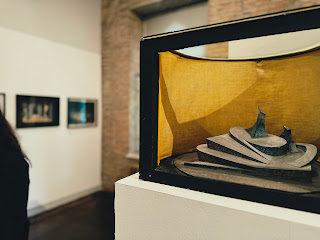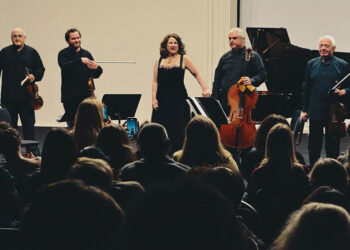Gamrekeli (1894–1943) was a painter, graphic artist, and the great reformer of Georgian stage design. His style carried the angled confidence of futurism and constructivism, yet it also allowed room for expressionist intensity and even the occasional sinuous flourish of art nouveau. The combination created a language that was both rigorous and theatrical, capable of turning the stage into something closer to an architectural score.
His route to theater was indirect. He trained in Tbilisi under Boris Fogel and Boris Shebuev, drifted into medical studies in Rostov and later at Tbilisi University, and spent a short time at the Tbilisi Academy of Arts. The decisive moment came in 1921, when director Kote Marjanishvili encountered two of his paintings, Malaria and Death Dance. Their stark theatricality convinced him to bring the young artist into the theater, assigning him Oscar Wilde’s Salome as a first commission.
From there, Gamrekeli’s path unfolded quickly. In 1923, the critic Kiril Zdanevich wrote that his designs announced a new direction for the Georgian stage, one that moved past folkloric scenery into a sharper, more modern visual language. Over the next two decades, Gamrekeli worked with Marjanishvili and Sandro Akhmeteli, creating scenographies that blended geometry with movement, clarity with rhythm. His sets for works by Grigol Robakidze, Ernst Toller, Shakespeare, and Schiller revealed a mind that treated stage design as both dramaturgy and architecture.
The Tsinandali exhibition presented this story in sketches, book designs, and archival material. His covers for the futurist journal H2SO4 and for modernist writers like Robakidze and Simon Chikovani showed how his sense of stage space extended naturally into typography and page layout. His involvement in Kote Mikaberidze’s 1928 film My Grandmother revealed his eye for cinematic architecture: staircases that lead nowhere, bureaucratic offices that look like distorted cathedrals. Later work at the Tbilisi Film Studio, including Arsena and Giorgi Saakadze, confirmed his ability to think across mediums.
Placed within the festival, the exhibition took on a particular resonance. The music performed at Tsinandali — works by Schubert, Mahler, and contemporary voices — thrives on counterpoint and structural clarity. Gamrekeli’s sketches, with their sharp diagonals and disciplined sense of rhythm, seemed to share that logic. His constructivist lines functioned almost like musical phrasing, carrying tension and release across the page. In this setting, scenography began to feel less like an ancillary art and more like a parallel form of composition.
Gamrekeli’s career ended in the 1940s, but the clarity of his vision still speaks to today’s audiences. At Tsinandali, surrounded by vineyards and music, his work appeared both archival and alive. The exhibition did not attempt to monumentalize him; it offered a quieter proposition — that stage design can shape cultural memory as powerfully as a symphony or a poem.
Review by Ivan Nechaev
Header image: Photo by the author














